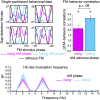Entrained neural oscillations in multiple frequency bands comodulate behavior
- PMID: 25267634
- PMCID: PMC4205645
- DOI: 10.1073/pnas.1408741111
Entrained neural oscillations in multiple frequency bands comodulate behavior
Abstract
Our sensory environment is teeming with complex rhythmic structure, to which neural oscillations can become synchronized. Neural synchronization to environmental rhythms (entrainment) is hypothesized to shape human perception, as rhythmic structure acts to temporally organize cortical excitability. In the current human electroencephalography study, we investigated how behavior is influenced by neural oscillatory dynamics when the rhythmic fluctuations in the sensory environment take on a naturalistic degree of complexity. Listeners detected near-threshold gaps in auditory stimuli that were simultaneously modulated in frequency (frequency modulation, 3.1 Hz) and amplitude (amplitude modulation, 5.075 Hz); modulation rates and types were chosen to mimic the complex rhythmic structure of natural speech. Neural oscillations were entrained by both the frequency modulation and amplitude modulation in the stimulation. Critically, listeners' target-detection accuracy depended on the specific phase-phase relationship between entrained neural oscillations in both the 3.1-Hz and 5.075-Hz frequency bands, with the best performance occurring when the respective troughs in both neural oscillations coincided. Neural-phase effects were specific to the frequency bands entrained by the rhythmic stimulation. Moreover, the degree of behavioral comodulation by neural phase in both frequency bands exceeded the degree of behavioral modulation by either frequency band alone. Our results elucidate how fluctuating excitability, within and across multiple entrained frequency bands, shapes the effective neural processing of environmental stimuli. More generally, the frequency-specific nature of behavioral comodulation effects suggests that environmental rhythms act to reduce the complexity of high-dimensional neural states.
Keywords: auditory perception; neuroscience; psychophysics.
Conflict of interest statement
The authors declare no conflict of interest.
Figures





References
-
- Lakatos P, Karmos G, Mehta AD, Ulbert I, Schroeder CE. Entrainment of neuronal oscillations as a mechanism of attentional selection. Science. 2008;320(5872):110–113. - PubMed
-
- Lakatos P, et al. An oscillatory hierarchy controlling neuronal excitability and stimulus processing in the auditory cortex. J Neurophysiol. 2005;94(3):1904–1911. - PubMed
-
- Bishop GH. Cyclic changes in the excitability of the optic pathway of the rabbit. Am J Physiol. 1933;103:213–224.
Publication types
MeSH terms
LinkOut - more resources
Full Text Sources
Other Literature Sources

